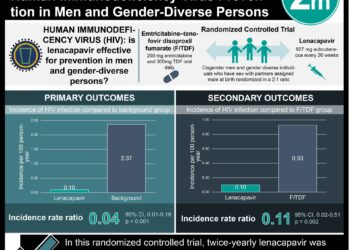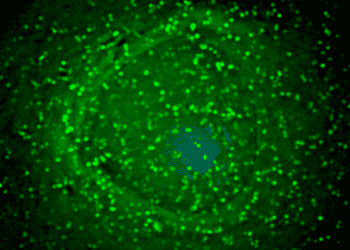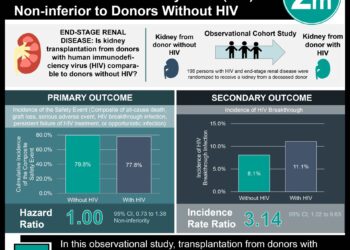HIV rebound observed after therapeutic stem cell transplant
1. In this case study, two patients with chronic HIV infection who underwent hematopoietic stem cell transplant achieved HIV remission for several weeks after their antiretroviral therapy was stopped.
2. However, both patients subsequently experienced viral rebound associated with the acute retroviral syndrome.
Evidence Rating Level: 4 (Below average)
Study Rundown: Latent HIV reservoirs pose a significant barrier to elimination of the virus, and require long-term suppression with antiretroviral therapy (ART). The authors previously described the depletion of peripheral blood HIV reservoirs in two male patients with chronic HIV-1 several years after allogeneic hematopoietic stem cell transplant (HSCT). In the present study, these two patients underwent “analytic treatment interruption” (ATI, i.e. the patients stopped taking ART while undergoing close monitoring for viral rebound) to determine if decreased reservoirs could lead to ART-free remission. Following ATI, both patients achieved temporary HIV remission, one for 13 weeks and the other for 32 weeks. However, both patients subsequently experienced viral rebound, accompanied by symptoms of the acute retroviral syndrome, and one was found to have new resistance to the antiretroviral efavirenz. Overall, the study found that although HSCT may result in substantial depletion of HIV reservoirs, latent infection persists and even a small number of residual infected cells can lead to viral rebound. Despite limitations from a small sample size, this analysis highlights the need to further characterize latent viral reservoirs as the pursuit of sustained ART-free HIV remission continues.
Click to read the study, published today in the Annals of Internal Medicine
Click to read an accompanying editorial in the Annals of Internal Medicine
Relevant Reading: Long-Term Control of HIV by CCR5 Delta32/Delta32 Stem-Cell Transplantation
In-Depth [case series]: In this case series, one patient underwent allogeneic HSCT for recurrent Hodgkin lymphoma, while the other underwent HSCT for myelodysplastic syndrome following treatment of non-Hodgkin lymphoma and subsequent Hodgkin lymphoma. ATI was initiated for these patients 4.3 and 2.6 years following HSCT, respectively. Prior to ATI, both patients were subjected to extensive viral reservoir characterization, including sampling of peripheral blood and gut-associated lymphoid tissue (one patient only), with no HIV-1 DNA or replication-competent HIV-1 found in any samples. Following ATI, viremia was detected by clinical viral load (VL) assay in one patient 84 days after ATI and 14 days after a negative clinical VL test. This virus demonstrated new efavirenz resistance. In the other patient, viremia was detected following onset of generalized symptoms 219 days after ATI and 8 days after a negative clinical VL test. Both patients experienced symptoms of the acute retroviral syndrome, but symptoms abated as viral load fell after ART was restarted. Notably, phylogenetic analysis of the resurgent virus suggested that the virus had emerged from only one or a few cells or latent proviruses. In addition, both patients had experienced graft-versus-host disease following HSCT, and the authors hypothesize that chronic, sub-clinical GVHD may have suppressed viral reservoirs and delayed viral rebound.
Image: PD
©2012-2014 2minutemedicine.com. All rights reserved. No works may be reproduced without expressed written consent from 2minutemedicine.com. Disclaimer: We present factual information directly from peer reviewed medical journals. No post should be construed as medical advice and is not intended as such by the authors, editors, staff or by 2minutemedicine.com. PLEASE SEE A HEALTHCARE PROVIDER IN YOUR AREA IF YOU SEEK MEDICAL ADVICE OF ANY SORT.







